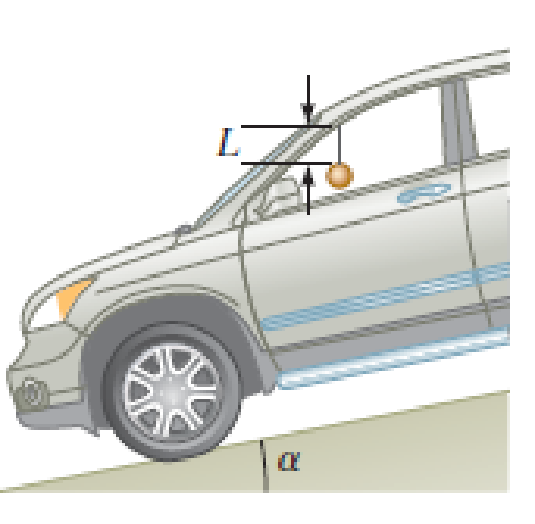
Concept explainers
The total energy of a simple harmonic oscillator with amplitude 3.00 cm is 0.500 J.
- a. What is the kinetic energy of the system when the position of the oscillator is 0.750 cm?
- b. What is the potential energy of the system at this position?
- c. What is the position for which the potential energy of the system is equal to its kinetic energy?
- d. For a simple harmonic oscillator, what, if any, are the positions for which the kinetic energy of the system exceeds the maximum potential energy of the system? Explain your answer.

FIGURE P16.73
(a)
The kinetic energy of the system.
Answer to Problem 74PQ
The kinetic energy of the system is
Explanation of Solution
Write an expression for the total energy of the system.
Here,
Rewrite the equation (I) to find
Write an expression for the potential energy of the system.
Here,
Write an expression for the kinetic energy of the system.
Here,
Substitute equation (I) and (III) in equation (IV).
Conclusion:
Substitute
Substitute
Thus, the kinetic energy of the system is
(b)
The potential energy of the system.
Answer to Problem 74PQ
The potential energy of the system is
Explanation of Solution
Write an expression for the potential energy of the system.
Conclusion:
Substitute
Thus, the potential energy of the system is
(c)
The position at which the potential energy of the system is equal to the kinetic energy.
Answer to Problem 74PQ
The position at which the potential energy of the system is equal to the kinetic energy is
Explanation of Solution
The potential energy will be half of the total energy if the potential energy and kinetic energy are same.
Write the expression for the potential energy
Substitute equation (I) and (III) in equation (VI).
Rewrite the equation (VII) to find
Conclusion:
Substitute
Thus, the position at which the potential energy of the system is equal to the kinetic energy is
(d)
The possibility of presence of a position for a simple harmonic oscillator at which the kinetic energy of the system exceeds the total potential energy of the system.
Answer to Problem 74PQ
No position exists for a simple harmonic oscillator at which the kinetic energy of the system exceeds the total potential energy of the system.
Explanation of Solution
The total mechanical energy is conserved for the system. The maximum potential energy is equal to the total energy of the system. The total energy of the system is the sum of kinetic energy and potential energy.
Since the total energy conserved, the total energy will be a constant. The kinetic energy can also attain a maximum that equal to the total energy. Thus, the kinetic energy will never exceed the maximum potential energy.
Want to see more full solutions like this?
Chapter 16 Solutions
Physics for Scientists and Engineers: Foundations and Connections
- Please solve this problem correctly please and be sure to provide explanation on each step so I can understand what's been done thank you. (preferrably type out everything)arrow_forwardUse a calculation to determine how far the fishing boat is from the water level .Determine distance Yarrow_forwardNo chatgpt pls will upvote Already got wrong chatgpt answerarrow_forward
- 2. 1. Tube Rating Charts Name: Directions: For the given information state if the technique is safe or unsafe and why. 60 Hertz Stator Operation Effective Focal Spot Size- 0.6 mm Peak Kilovolts MA 2 150 140 130 120 110 100 90 80 70 2501 60 50 40 30 .01 .02 .04.06 .1 .2 .4.6 1 8 10 Maximum Exposure Time In Seconds Is an exposure of 80 kVp, 0.1 second and 200 mA within the limits of the single phase, 0.6 mm focal spot tube rating chart above? Is an exposure of 100 kVp, 0.9 second and 150 mA within the limits of the single phase, 0.6 mm focal spot tube rating chart above?arrow_forwardQ: You have a CO2 laser resonator (λ = 10.6 μm). It has two curved mirrors with R₁=10m, R2= 8m, and mirror separation /= 5m. Find: R2-10 m tl Z-O 12 R1-8 m 1. Confocal parameter. b= 21w2/2 =√1 (R1-1)(R2-1)(R1+R2-21)/R1+R2-21) 2. Beam waist at t₁ & t2- 3. Waist radius (wo). 4. 5. The radius of the laser beam outside the resonator and about 0.5m from R₂- Divergence angle. 6. Radius of curvature for phase front on the mirrors R₁ & R2-arrow_forwardNo chatgpt pls will upvotearrow_forward
 Physics for Scientists and Engineers: Foundations...PhysicsISBN:9781133939146Author:Katz, Debora M.Publisher:Cengage Learning
Physics for Scientists and Engineers: Foundations...PhysicsISBN:9781133939146Author:Katz, Debora M.Publisher:Cengage Learning College PhysicsPhysicsISBN:9781938168000Author:Paul Peter Urone, Roger HinrichsPublisher:OpenStax College
College PhysicsPhysicsISBN:9781938168000Author:Paul Peter Urone, Roger HinrichsPublisher:OpenStax College University Physics Volume 1PhysicsISBN:9781938168277Author:William Moebs, Samuel J. Ling, Jeff SannyPublisher:OpenStax - Rice University
University Physics Volume 1PhysicsISBN:9781938168277Author:William Moebs, Samuel J. Ling, Jeff SannyPublisher:OpenStax - Rice University Principles of Physics: A Calculus-Based TextPhysicsISBN:9781133104261Author:Raymond A. Serway, John W. JewettPublisher:Cengage Learning
Principles of Physics: A Calculus-Based TextPhysicsISBN:9781133104261Author:Raymond A. Serway, John W. JewettPublisher:Cengage Learning Physics for Scientists and Engineers, Technology ...PhysicsISBN:9781305116399Author:Raymond A. Serway, John W. JewettPublisher:Cengage Learning
Physics for Scientists and Engineers, Technology ...PhysicsISBN:9781305116399Author:Raymond A. Serway, John W. JewettPublisher:Cengage Learning College PhysicsPhysicsISBN:9781305952300Author:Raymond A. Serway, Chris VuillePublisher:Cengage Learning
College PhysicsPhysicsISBN:9781305952300Author:Raymond A. Serway, Chris VuillePublisher:Cengage Learning





